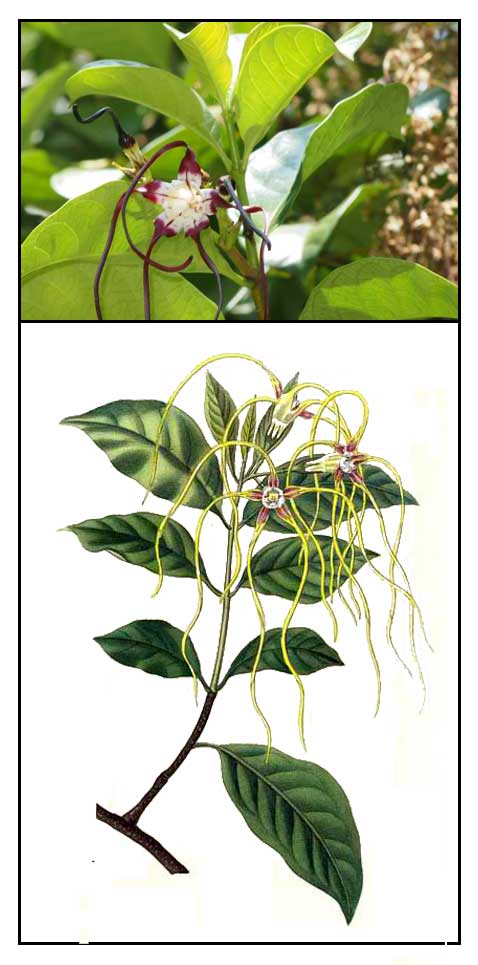
Family • Apocynaceae
Abuhab-baging
Sara-sara
Strophanthus caudatus (L.) Kurz
TWISTED CORD FLOWER
Luan e yang jiao niu
| Scientific names | Common names |
| Apocynum floristratum Noronha | Abuhab-baging (Tag.) |
| Echites caudatus L. | Lanot (Ilk.) |
| Nerium caudatum (L.) Lam. | Lasiu (Ibn.) |
| Nerium scandens Lour. | Lasuiu (Ibn.) |
| Strophanthus caudatus (L.) Kurz. | Sara-sara (Ilk.) |
| Strophanthus caudatus var. billardierei Franch. | Medusa gorgona (Engl.) |
| Strophanthus caudatus var. giganteus Pit. | Red rapunzel (Engl.) |
| Strophanthus caudatus var. javensis Franch. | Twisted cord flower bush (Engl.) |
| Strophanthus caudatus var. lanceolatus Franch. | |
| Strophanthus caudatus var. macrophyllus Franch. | |
| Strophanthus caudatus f. marckii (A.DC.) Franch. | |
| Strophanthus caudatus f. undulatus Franch. | |
| Strophanthus cumingii A.DC. | |
| Strophanthus dichotomus DC. | |
| Strophanthus dichotomus var. cochinchinensis Ker Gawl. | |
| Strophanthus dichotomus var. loureiroi A.DC. | |
| Strophanthus dichotomus var. luzoniensis S.Vidal | |
| Strophanthus dichotomus var. marckii A.DC. | |
| Strophanthus erectus Merr. | |
| Strophantus giganteus Pierre. | |
| Strophanthus griffithii Wight | |
| Strophanthus horsfieldianus Miq. | |
| Strophanthus letei Merr. | |
| Strophanthus longicaudatus Wight | |
| Strophanthus macrophyllus (Franch.) Pierre | |
| Strophanthus pierrei F.Heim | |
| Strophanthus scandens (Lour.) Roem. & Schult. | |
| Strophanthus terminalis Blume | |
| Quisumbing's compilation lists Strophanthus letei Merr. (Sarasara) as a separate species from Strophanthus cumingii A. DC. Plants of the World Online lists both S. letei and S. cumingii as synonyms of Strophanthus caudatus (L.) Kurz. | |
| Strophanthus cumingii A.DC. is a synonym of Strophanthus caudatus (L.) Kurz. | |
| Strophanthus caudatus (L.) Kurz is an accepted species. KEW: Plants of the World Online | |
| Note: Sara-sara (Strophanthus letei Merr.) and Abuhab-baging (Strophanthus caudatus L.) are synonyms, and have been merged into one entry as Abuhab-baging. | |
| Other vernacular names |
| CHINA: Luan e yang jiao niu. |
| MALAYSIA: Tandok-tandok, Tanduk-tanduk, Dudur kijang. |
| VIETNAM: Sung chau. |
Botany Strophanthus caudatus is a trailing shrub to a woody climber that can grow up to 12 m long. Leaves are opposite, shortly stalked, wit thickly papery to leathery leaf blades that are elliptic-oblong or drop-shaped and measures 4.2 - 17.5 cm long, 1.5–7.5 cm across, with 6-12 pairs of veins. Leaf blade has acuminate to rounded leaf tip, and cuneate base. Stems are about 2 cm in diameter. Bark is dark and dotted with many lenticels. Flowers grow in axillary, stalked, few-flowered clusters. Calyx lobes are egg-shaped, and 0.6 cm wide, with long narrow tails. Its corolla-tube is white and 1.3 cm long with purplish-red lobes with white and yellow in the center. Fruits are large and woody, green, oblong-shaped, and about 10-30 cm long, 1.9-4.8 cm in diameter, wit small grain-like seeds.
Constituents Properties Studies Availability |
Updates June 2023 / January 2017
![]()
 |
PHOTOS / ILLUSTRATIONS |
| OTHER IMAGE SOURCE: Photo: Twisted Cord Flower Bush (Strophanthus caudatus) / © URBAN Tropicals / Non-commercial use / Click on image or link to go to source page / URBAN Tropicals |
| IMAGE SOURCE: Flowering stem / Strophanthus caudatus / Photograph by Yee Alex Thiam Koon / Creative Commons • CC by NC.SA 2.0 / click on image or link to go to source page / Useful Tropical Plants |
| OTHER IMAGE SOURCE: Illustration / Apocynaceae-Strophanthus caudatus - S. dichotomus / From I'horticulteur universal. journal general des jardiniers et amateurs by Charles Lemaire (editor), Paris, H. Cousin, 1841, Vol 2. Hand-coloured engraving / Click on image to go to source page / Meemelink |
| Additional
Sources and Suggested Readings (1) Studies on Philippine medicinal plants. I. Paper chormatography and spectrophotometric determination. / Manalo GD, Lleander GC / Philippine Journal of Science, 1961 (2) Strophanthus / The Full Wiki (3) Strophanthus caudatus / Synonyms / KEW: Plants of the World Online (4) THE CARDIOACTIVE SCREENING OF THE EXTRACT FROM THE BARK OF STROPHANTHUS CUMINGII A.DC. (APOCYNACEAE) USING ISOLATED FROG HEART / Maribeth R. Laurente, Mafel C. Ysrael / Int J Pharm 2015; 5(4): pp 1048-1050 (5) Also read: Sarasara (6) Strophanthus caudatus / National Parks: FLORA & FAUNA WEB (7) TRADITIONAL MEDICINAL PLANTS IN BEN EN NATIONAL PARK, VIETNAM / Hoang Van Sam, Pieter Baas, Paul J A Kebler / BLUMEA, 2008; 53: pp 569-601 / DOI: 10.3767/000651908X607521 (8) Ethnobotanical Survey of Medicinal Plants used by Ayta Communities in Dinalupihan, Bataan, Philippines/ Ourlad Alzeus G. Tantengco, Marlon Lian C. Condes, Hanna Hasmini T. Estadilla, Elena M. Ragragio / Pharmacogn J., 2018; 10(5): pp 859-870 (9) Screening of α-Glucosidase Inhibitory Activity from Some Plants of Apocynaceae, Clusiaceae, Euphorbiaceae, and Rubiaceae / Berna Elya, Katrin Basah, Abdul Mun’im, Wulan Yuliastuti, Anastasia Bangun, and Eva Kurnia Septiana / Journal of Biomedicine and Biotechnology, 2012; Article ID 281078 / doi:10.1155/2012/281078 |
• |
DOI: It is not uncommon for links on studies/sources to change. Copying and pasting the information on the search window or using the DOI (if available) will often redirect to the new link page. (Citing and Using a (DOI) Digital Object Identifier) |
| List of Understudied Philippine Medicinal Plants |
• |
 |

 Gen info
Gen info Distribution
Distribution